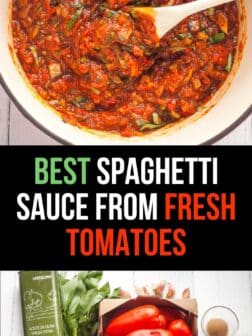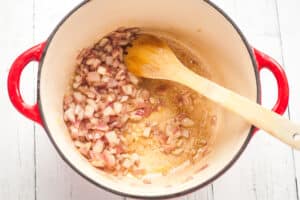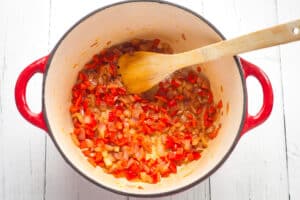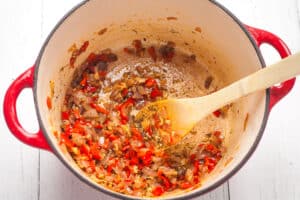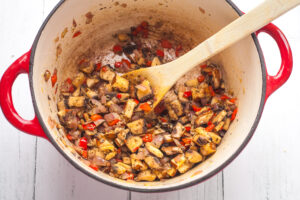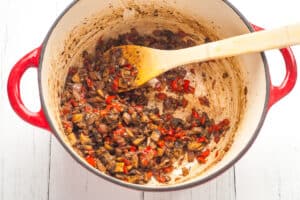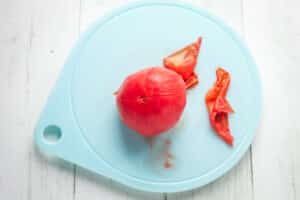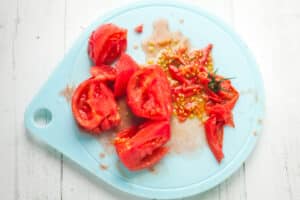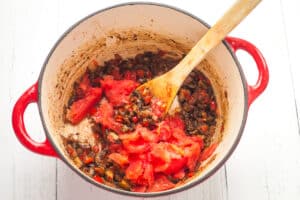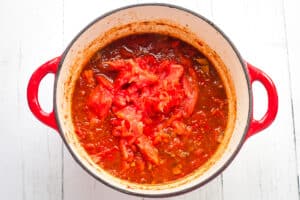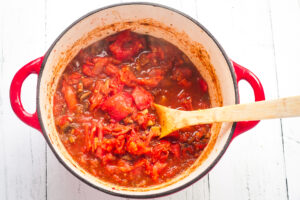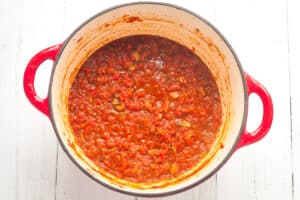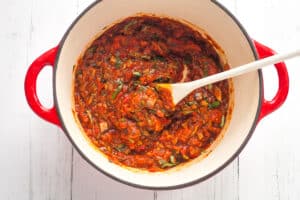A chunky homemade spaghetti sauce with fresh tomatoes and veggies. This is simple to make with any large tomatoes and can be customized to your family’s preferences! This sauce embraces the sweet taste of fresh summer tomatoes alongside other veggies for varied texture and flavor. A great way to use up a surplus of garden tomatoes and it’s freezer friendly, so you can enjoy it year round.
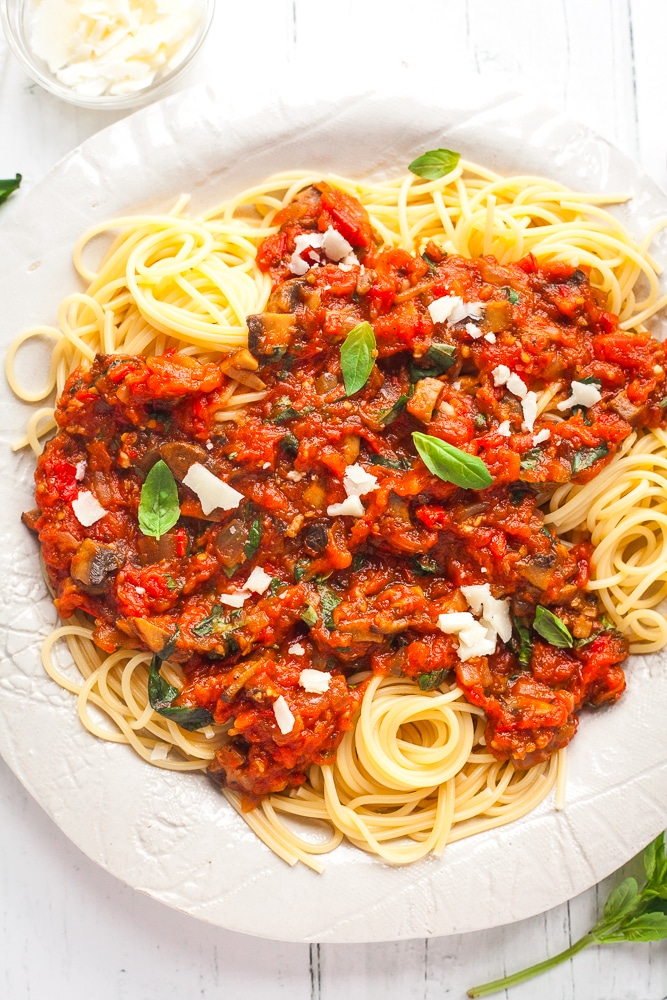
If you’re looking for a way to transform a haul of fresh garden tomatoes into a pot of homemade sauce for spaghetti night, I can help! After a number of tests, I do believe I have arrived at the perfect recipe for a veggie forward spaghetti sauce made from fresh tomatoes.
This recipe works with any kind of larger tomatoes – whether they be plum tomatoes, vine tomatoes or heirloom tomatoes. It uses no gadgets – you don’t need a food mill, food processor or blender. It can be used as a base recipe to adapt to your own preference, there is no need to follow it to the letter. Every batch you make will be a little bit different, and that is the joy of cooking with fresh produce!
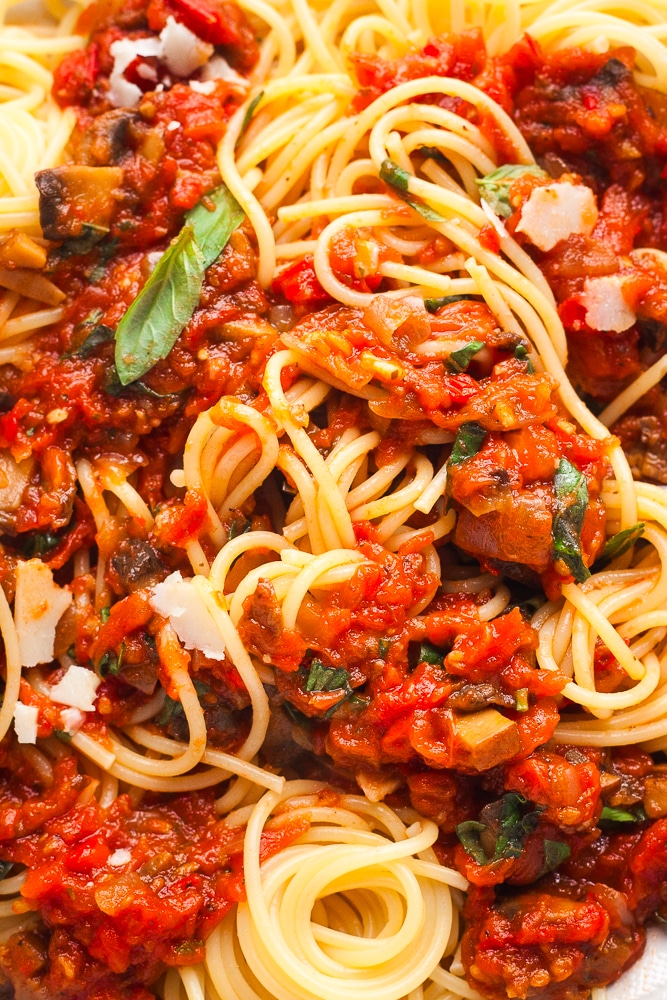
So what kind of sauce is this?
This is the kind of sauce that is best enjoyed chunky and packs in lots of “stuff” (mushrooms, peppers and onions in this case). Which is what I tend to think of as a “spaghetti sauce” rather than a straight tomato sauce.
But unlike my other spaghetti sauce recipe which is made with canned tomatoes and focuses on creating very deep umami flavors, this recipe uses fresh tomatoes and tries to leave room for that sweet juicy flavor to shine through. So we don’t use as many ingredients; we let our tomatoes do more of the work.
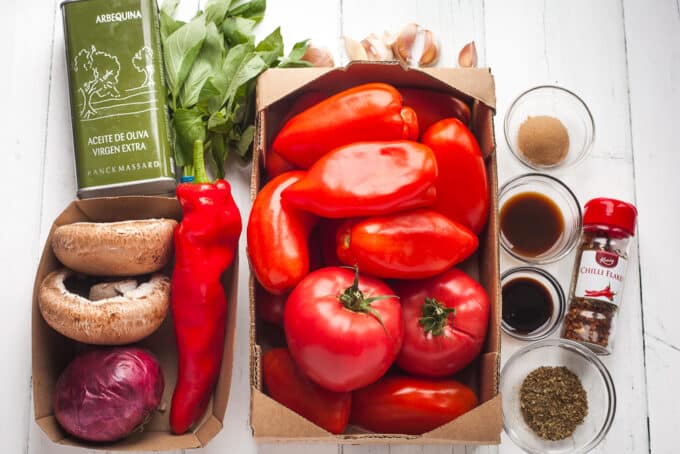
What tomatoes are best for making spaghetti sauce?
Technical answer: Plum tomatoes (including Roma and San Marzano) are superior for sauce making, because they are more “fleshy” so you get more substance out of them. So if you’re going shopping for tomatoes to make sauce with, or planting up your garden with sauce in mind, you want plum varieties.
My real world answer: The tomatoes you have. Because if you’ve got a giant haul of tomatoes it’s likely that you either a) grew them or b) happened upon them at a market, so your tomato haul is influenced by what is available, what is local and affordable. You can make a decent sauce with whatever you’ve got. The only caveat is that this recipe is not designed for cherry or baby tomatoes (I have plenty more recipes that are though!)
What to expect from different types of tomatoes:
- As we’ve already addressed, plum tomatoes (Roma, San Marzano, etc) are optimal for sauce making because of their lower water content and the amount of “flesh” they yield. You will get a substantial sauce fairly quickly (a few hours) from these tomatoes.
- Beefsteak tomatoes, the big round ones, are more juicy. The sauce will need longer to cook down and it the yield will be a little smaller. You can compensate for this by going a little over the recipe amount — or just accepting you will have a higher veggie to tomato ratio, which is fine too!
- Vine / Campari tomatoes will similarly lose a lot more of their weight in evaporating juices. And unless you come across some super huge ones, it is going to take a lot longer to peel enough to make a sauce. If you are up for the challenge, go for it! You’ll be rewarded with extra sweet sauce.
- Heirloom tomatoes can go any which way. Some heirlooms (such as Oxhearts and Brandywines) are really fleshy and ideal for sauce while others (like some of the yellow varieties) are more watery. So the cook time and yield will vary a little. If you have a mixed bunch of heirlooms, just throw them all in and see where you land.
FYI: The batch you see in these photos was mostly plum tomatoes, with a couple of beefsteaks thrown in.
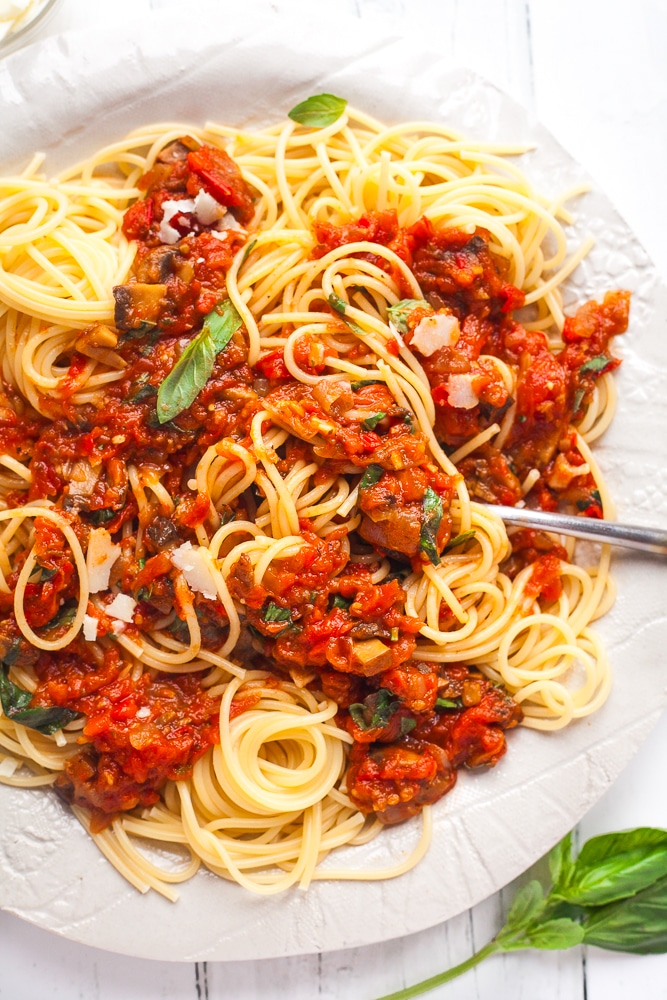
The process isn’t quick, but it’s efficient
The fact is, making sauce from fresh tomatoes takes time and it is a very hands-on process at the start. With that in mind, I have at least tried to make this feel efficient and tidy.
I think that peeling your tomatoes is worthwhile (though I am not meticulous with the de-seeding) but I have settled into a method I really like which makes this less of a drag. Instead of prepping the tomatoes before we start cooking, we get the rest of our ingredients cooking first, and then as we peel and de-seed we can add them straight into the pot one by one.
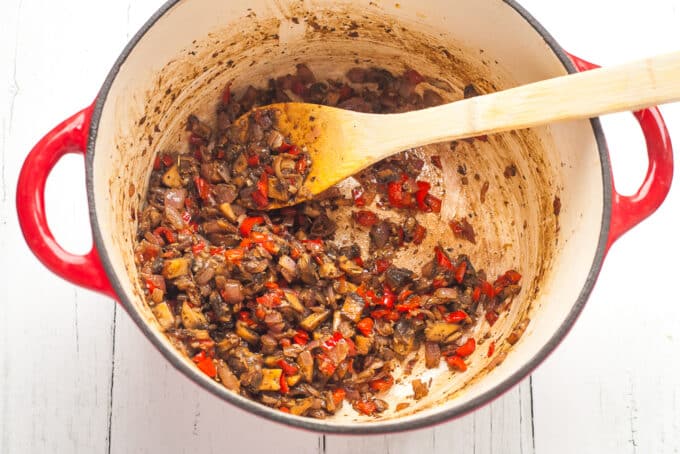
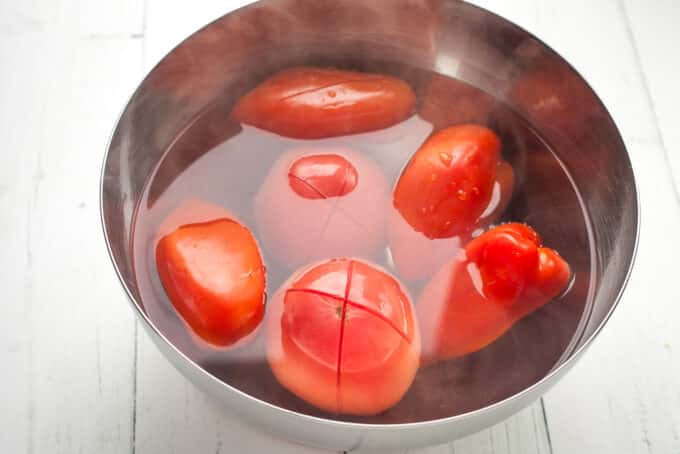
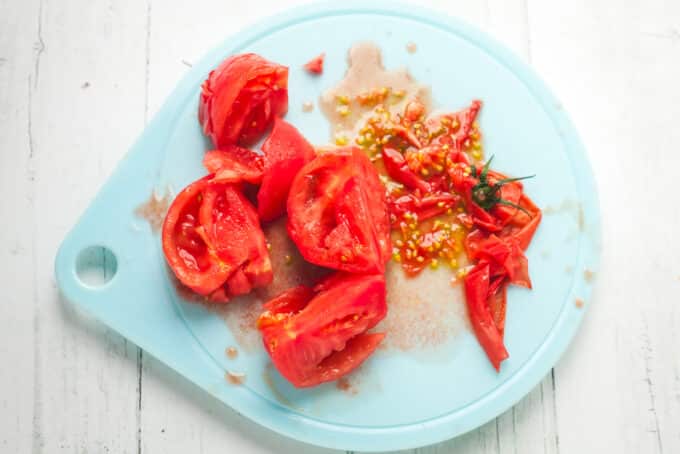
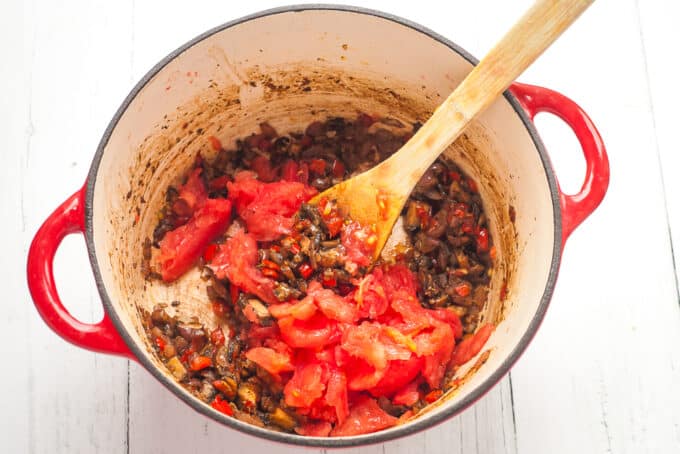
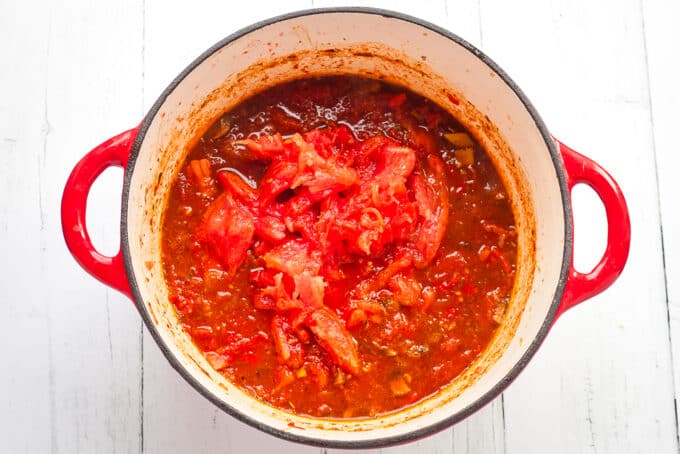
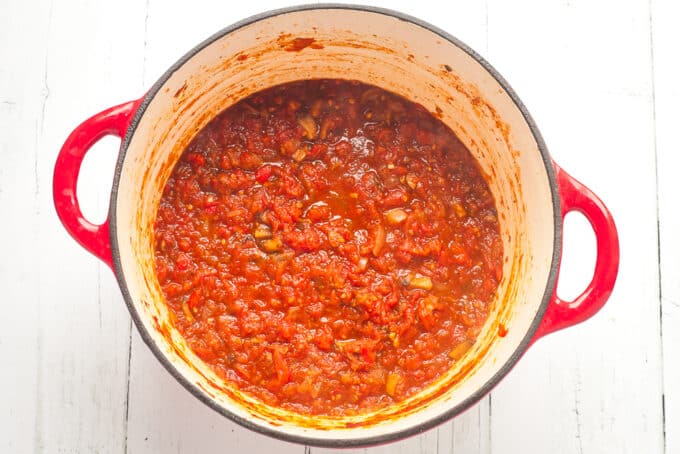
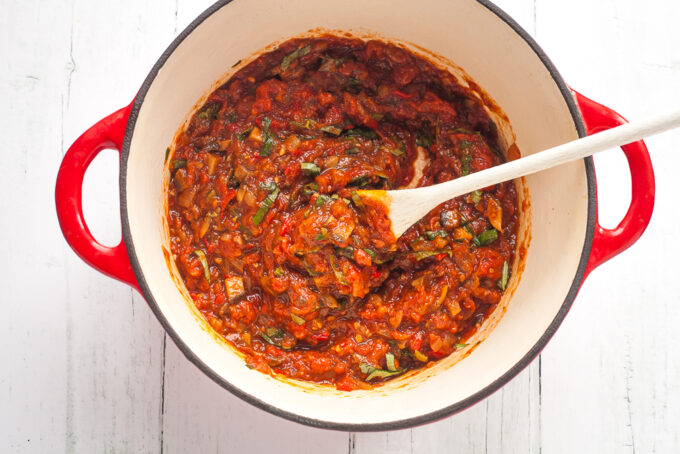
This saves some time, it saves some prep bowls, and it gives the sauce a head start in cooking down those tomatoes. As you can see, by the time I added the last tomatoes, the earlier ones were already well on their way.
For a speedier sauce:
If you are concerned about how long this is going to take and really need to speed things up…
- Halve the recipe quantity and cook it in a wide bottomed, shallow braiser, frying pan or saute pan. Like the one I used for my yellow tomato sauce. The shallower the sauce is in the pan, the quicker the liquid will evaporate.
- Let it cook fully uncovered and on a slightly higher heat to maximise evaporation. Ideally I would prefer to leave it semi-covered and cook it on a low heat – I find that this way it cooks a little more evenly, won’t stick to the bottom if I don’t stir it for a while, and won’t spit sauce all over my stovetop. But if you choose to go without the lid entirely, it will definitely will cook faster- just be mindful to stir it often and watch the heat.
- Tomato paste is a common addition to sauces to help them thicken. I personally try to avoid this at all costs when I’m cooking with fresh tomatoes because I find it overpowers the subtle sweetness that fresh tomatoes provide. But I couldn’t not mention it. Some would also recommend adding a cornstarch slurry, though I’ve never tried this.
- Mascarpone cheese and/or grated parmesan will help to thicken up any remaining watery bits if you like the idea of a creamier sauce.
- You can also just let the sauce be a little soupy, and serve it in a deep dish with rigatoni instead of spaghetti.
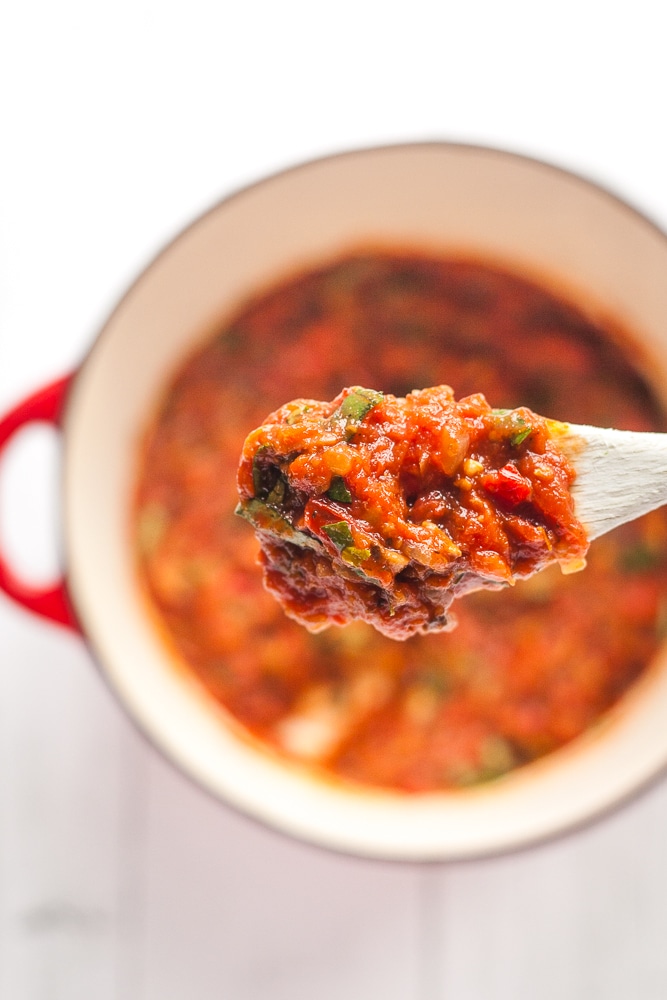
Make it your own: How to customize this sauce
- Swap the veggies around as you wish, but I would suggest trying to keep the ratio of veggies – tomato about the same. Other veggies that would make sense here would be eggplant, green pepper or zucchini.
- The sauce is vegan as written but if you don’t need it to be vegan, you can definitely add some parmesan or asiago if you wish to enhance the flavor.
- While my recipe suggests a couple pinches of chili or red pepper flakes, you can also make it arrabiata style with diced red chili if you particularly enjoy spicy sauces. If you enjoy the flavors or capers and olives, they are welcome additions here too.
- Add a little cream at the end if you would like the extra richness.
Not quite right? Try these other fresh tomato sauce options
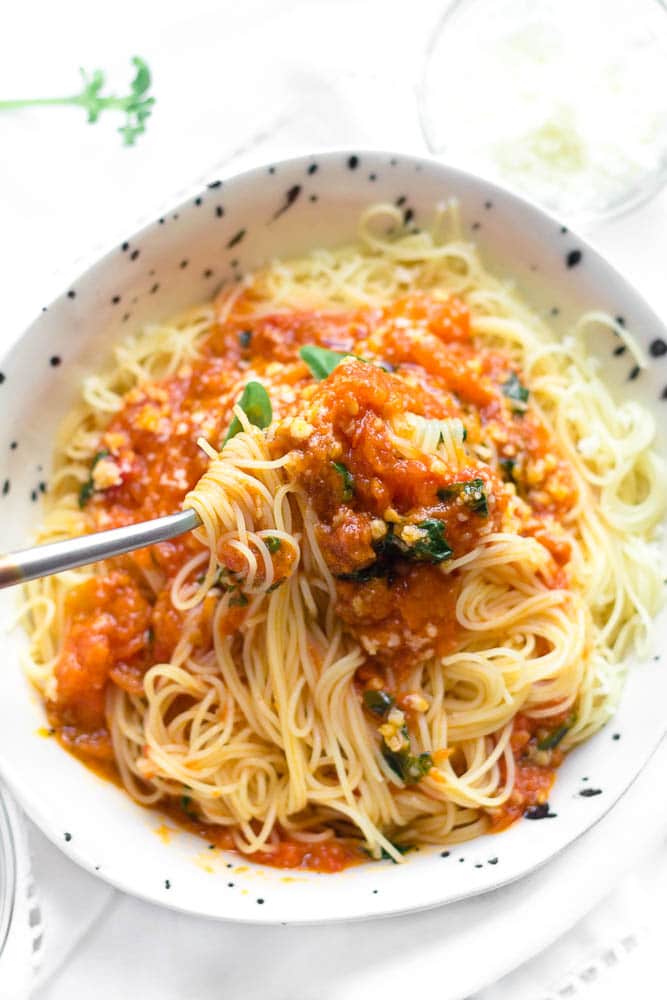
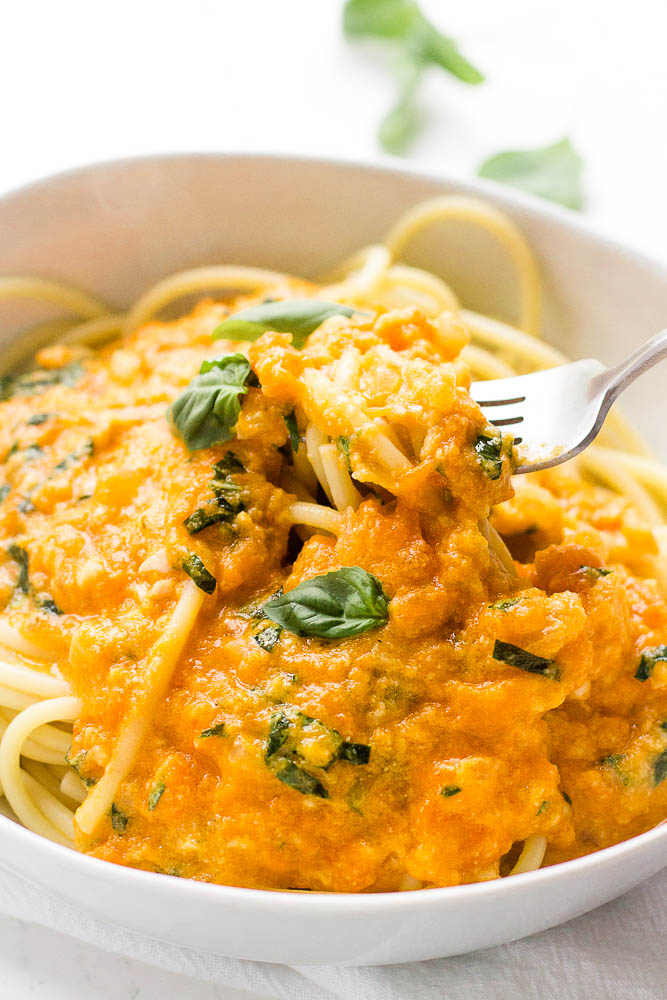
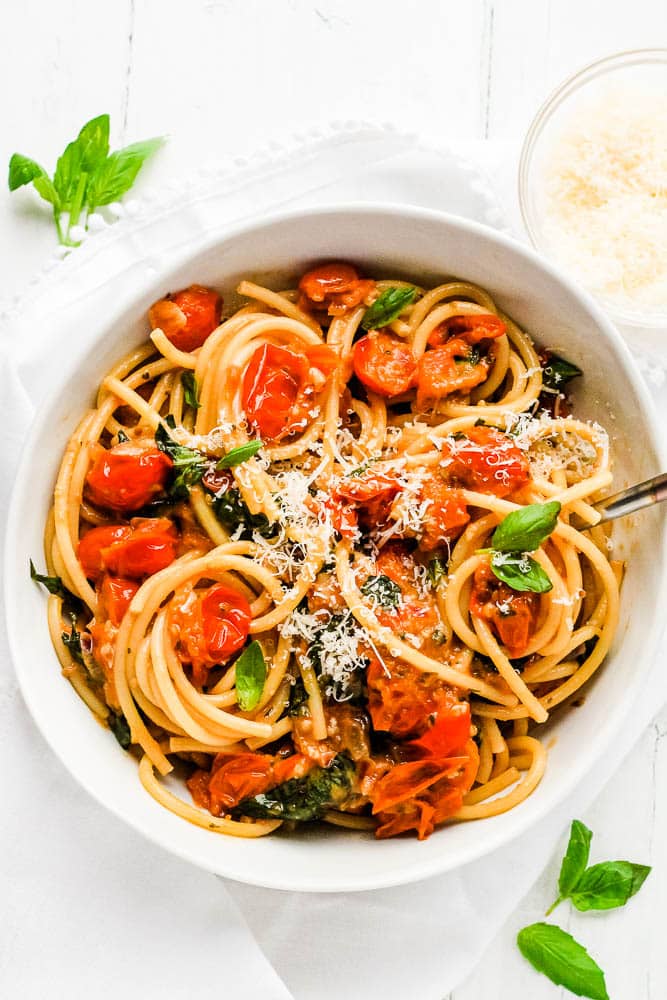
- For something easier, without all the extras, this 6 ingredient Butter Heirloom Tomato Sauce is ideal. Make with any tomatoes, they don’t have to be heirlooms.
- Yellow tomatoes will shine in this Yellow Tomato Sauce, which is also on the purer side with minimal ingredients but includes the luxurious additions of parmesan and mascarpone. (You can also make this sauce with any colour of tomatoes.)
- Cherry or grape tomatoes can shine in this Bucatini Pomodoro (you can use any pasta)
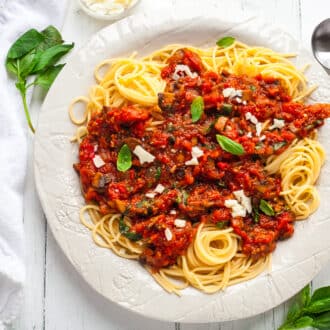
Spaghetti Sauce Made With Fresh Tomatoes
Ingredients
- 2-4 tbsp extra virgin olive oil, for cooking
- 4.5 lbs (2 kg) large tomatoes , plum, heirloom or vine varieties are all workable here
- 1 large red onion, finely diced
- 5 oz (150 g) mushrooms, finely chopped
- 1 sweet pepper or bell pepper, finely chopped
- 6 cloves garlic, crushed
- pinch red pepper or chili flakes, to taste
- 1 Tablespoon dried Italian herbs
- 1 Tablespoon balsamic vinegar
- 1 Tablespoon worcester sauce
- 1 Tablespoon brown sugar
- 1 bunch fresh basil, chopped
Instructions
- In a large pot, heat a thin layer of olive oil and saute the diced onions until they are reduced and softened.2-4 tbsp extra virgin olive oil, 1 large red onion
- Add the diced pepper and saute for another few minutes until they are also reduced and softened.1 sweet pepper or bell pepper
- Add the garlic and mix through until the fragrance starts to pop, then add the herbs and chili flakes (if using) and mix them through. Don't linger here – once it's all mixed together, move on to the next step because we don't want the garlic or herbs to burn!6 cloves garlic, 1 Tablespoon dried Italian herbs, pinch red pepper or chili flakes
- Add the mushrooms and mix through, then very quickly add in the Worcestershire sauce and balsamic vinegar. Mix through – if the pan seems too dry, add a little more oil or a dash of wine to help loosen it back up, but the mushrooms will soon start to release their liquid and cook down.5 oz mushrooms, 1 Tablespoon balsamic vinegar, 1 Tablespoon worcester sauce
- Allow the vegetables to cook over a low heat until they are well reduced and somewhat caramelized. Then remove them from the heat while you prep the tomatoes
- In a large bowl or pot, place as many tomatoes as you can fit in one layer. Cut an X shape through the skins. Pour boiling water over the top and let them soak. (This works best if you have an electric kettle – if you don't, you will find it easier to bring the pot of water to boil and then add the tomatoes in)4.5 lbs large tomatoes
- Allow the tomatoes to soak just for a minute or two. Remove from the water and you should find the skins peel away very easily from the spot where you sliced them.
- Peel the skin from the tomato, remove the stem and then slice it into halves or quarters. Remove the most obvious seeds – usually the slightly jelly-like membranes come out easily, but don't go overboard trying to get them all out.
- Add the tomato straight into the pot with the vegetables. You can tear the tomatoes or crush them a little with your hands as you add them in to break them up (but they'll cook down on their own eventually so you don't have to.)
- Once you've added a couple of tomatoes, put the pan back onto a low heat and let it simmer while you work your way through the the whole batch of tomatoes.
- Repeat until all of the tomatoes are in the pot, then add the brown sugar and give it all a good stir.1 Tablespoon brown sugar
- Allow to simmer for 1.5-3 hours (maybe longer if you're not using plum tomatoes). Leave the lid slightly ajar to allow liquid to escape. Stir regularly and check the texture – if the tomatoes are too chunky, you can use a potato masher to break them up and get the texture more homogenous.
- Once the sauce has reduced to your liking, you're done! Add the chopped basil through and serve.1 bunch fresh basil

